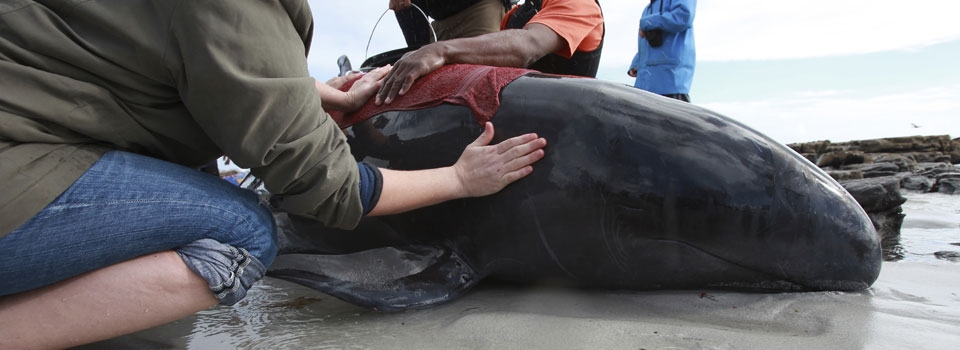- RESEARCH
- LEARN
- Camps »
- Resources »
- Kids Zone »
- SHOP

- Providing Sanctuary and a Forever Home since 1984.
- A not-for-profit 501(c)3 marine mammal education and research facility for more than 35 years.
- Providing Sanctuary and a Forever Home since 1984.
A not-for-profit 501(c)3 marine mammal education and research facility for more than 35 years.
Stranding Overview
Stranding Overview
“It is not known why they sometimes run aground on the seashore; for it is asserted that this happens rather frequently when the fancy takes them and with no apparent reason.” -Aristotle
The mystery of stranded marine mammals has continued to intrigue humankind since the first recordings of such events by the ancient Greeks, more than twenty-three hundred years ago. Even though many centuries have passed, we still are not much closer than the ancient Greeks to understanding why marine mammals strand. Experts have striven for years to explain the mystery, hoping to use that information in rescuing and rehabilitating animals in need of help.
Definition Of A Stranding
A stranding is defined as when marine mammals (such as cetaceans, pinnipeds or sirenians), either come ashore alive under abnormal circumstances, are injured close to shore, or wash ashore dead, whether individually or in groups.
References:
Geraci, J. R. and A. J. Lounsbury. 1993. Marine Mammals Ashore: A Field Guide for
Strandings. Texas A & M University Sea Grant College Program: Galveston, TX.
DRC's Stranding Experience
Dolphin Research Center's Stranding Experience
Regulatory Authority
In 1972, the U.S. federal government was given legal authority to deal with stranded marine mammals by the induction of the Marine Mammal Protection Act. In the State of Florida, the law is carried out by three governing agencies. NOAA Fisheries directs cetacean and pinniped stranding responses. The U.S. Fish and Wildlife Service, along with the Florida Department of Environmental Protection, directs manatee stranding responses. Any person or marine facility that wishes to participate in rescuing marine mammals must apply for a Letter of Authorization issued by the appropriate governing agencies. Any involvement in marine mammal rescues without an LOA holder on site is illegal and considered harassment.
Stranding Network
For decades, Dolphin Research Center operated as the southernmost member of the Southeast United States Marine Mammal Stranding Network (SEUS). This network covers all coastlines of North Carolina, running south to Florida, and then proceeding around the Gulf of Mexico from Florida to Texas and New Mexico. Puerto Rico and the U.S. Virgin Islands are also members of SEUS.
The Northeastern network is organized by states from Virginia north through Maine and west through the Great Lakes region to Minnesota. The Southwestern region includes California and Hawaii. Oregon and Washington are within the Northwestern network, and the fifth U.S. stranding region is the Alaskan network. A regional coordinator manages each network. The Southeastern coordinator is Blair Mase-Guthrie. The responsibilities of the coordinator include maintaining a stranding database, outfitting all stranding members with proper materials such as report forms and tissue sampling equipment, and providing an effective communication channel for stranding centers in the region.
All stranding networks are completely voluntary. Time and money are donated by private citizens, businesses, and rescue facilities. Additionally, an amendment to the Marine Mammal Protection Act allows funding for catastrophic events involving marine mammals. This act is cited as the “Marine Mammal Health And Stranding Response Act” (MMHSRA) and was established to create organized responses to mass strandings, systematic assessments, standardized methods for the reporting of strandings, and a formal system for collecting data and tissue samples. Each region recieves $10,000 annually for training and tissue banking and $15,000 to $300,000 for unusual mortality events from the MMHSRA.
In 1992, DRC extended our commitment to include the endangered manatee, becoming the only facility in the Florida Keys permitted by the U.S. Fish and Wildlife Service to respond to manatees in distress. Due to the appearance of cetacean morbillivirus, a lethal disease found in wild cetacean populations, DRC no longer responds to cetacean strandings as exposure to the disease would pose a threat to DRC’s colony. Instead, DRC has focused all of its efforts and resources on rescuing injured manatees.
Stranding Network Objectives
- To minimize the possible threat of beached and stranded marine mammals to human health and safety.
- To minimize the pain and suffering of live stranded animals and work towards better methods of rehabilitation.
- To derive the maximum possible scientific and educational benefit from both live and dead marine mammals.
- To establish a long-term program of data collection.
Why Do Whales Strand?
Why Do Whales Strand?
Many factors may contribute to the stranding of a marine mammal, and researchers are still looking for answers.
Some of the natural influences that have been suggested as reasons for marine mammals stranding are:
- Their sophisticated navigational systems somehow become impaired
- Magnetic disturbances cause marine mammals to make errors in navigation while following geo-magnetic contours
- Gentle sloping beaches create improper surface areas for reflecting their sonar waves
- Complex topographic and oceanographic conditions confuse them
- They are chased inshore by predators
- They are sometimes overzealous in their pursuit of food, following prey too far inshore
- They get lost for unknown reasons
- They are sick or injured and come ashore to rest or avoid drowning
- Weak, malnourished orphans wander inshore
- Severe weather conditions drive animals off their normal pathway
- Social cohesion results in mass strandings; i.e., pod members follow another ashore for reasons unknown, but suspected to be a result of social factors, such as responding to “cries” of distress
- Age, illness and disease
We cannot ignore our own role when researching why marine mammals strand. More and more animals are paying the price for people’s abuse of the environment we share, as evidenced in die-offs and strandings worldwide. Human-technological factors in strandings include:
- Chemical pollution (toxic waste, runoff, oil spills) causing high levels of toxins in the bodies of marine mammals
- Marine debris (ingestion of plastics and other garbage)
- Noise pollution, such as drilling and blasting, which may interfere with sonar navigation
- Fisheries interaction with nets, causing injury and/or confusion
- Injuries from boat strikes
- Injuries from accidental hooking or entanglement
- Human predation and aggression (direct assault with guns, hunting and harpooning).
What Should I Do If I Find A Stranded Animal?
What Should You Do If You Find A Stranded Animal?
- Resist the impulse to push the animal back out to sea. It is not normal for most marine animals to beach themselves. If you push them back out to sea, whatever is wrong with them may cause them to re-beach themselves somewhere more remote where no one can help them. Allow a qualified rescue team to judge if the animal is sick and in need of medical treatment.
- Call the Coast Guard or Marine Patrol as soon as possible. They will contact a rescue team to assess the situation.
- While you wait for the rescue team, follow their directions as to whether or not you can safely keep the animal cool and wet. A whale out of the water in a warm environment will quickly overheat and sunburn. You can help by providing shade and continuously splashing water over its body. Avoid splashing water in the blowhole, and keep the blowhole free from obstructions. However, please be careful with any help you provide. Even in the presence of an expert, a stranded animal can still be dangerous.
- Especially stay away from the back tail flukes. Stranded animals may thrash their tails around, and a person in the way can be seriously injured.
How Marine Mammal Rescue Teams Operate
How Marine Mammal Rescue Teams Operate
Due to the threat of morbillivirus, Dolphin Research Center is no longer involved in cetacean strandings, however the following protocol is standard for all cetacean strandings.
Assessment
When notification of a stranded animal is received, the rescue center dispatches an assessment team composed of members who hold Letters of Authorization. Their job is to quickly reach the site of the stranding and analyze the situation, determining:
- Is it an animal? Rescuers have responded to reports that turned out to be everything from an inner tube to a coconut.
- Is it alive or dead?
- What is the species?
- How large is it?
- Is it visibly sick or injured?
- Can the site be reached by land and/or water?
- What materials are needed for transport to a rehabilitation site?
This information is quickly sent back to the rescue center and a rescue team gathers necessary equipment and departs to the site.
While the rescue team is on the way, the assessment team makes the animal as comfortable as possible. They provide shade to prevent sunburn and if necessary, may physically support the animal to keep the blowhole above water.
Transport
It usually is not realistic to try and rehabilitate a marine mammal at the stranding site, for a variety of reasons. Keep in mind that the rehabilitation process sometimes takes many months.
Easy access to the animal is very important. If the animal is located on a sandbar many miles out from land, getting there with proper medical equipment is extremely difficult.
If stranded animals are injured or sick, the majority of the time they have bleeding abrasions. When nightfall comes, so do the predators, like sharks. Transport to a rehabilitation center is safer for all.
Access to electricity, running fresh water, refrigeration for food, phone lines, shade, and protection from severe weather conditions all are crucial to carrying out rehabilitation.
When the rescue team arrives, the animal is prepared for transport to the rehabilitation site. Care must be taken not to accidentally transmit diseases to healthy animals already at the rescue center. If an animal has a viral or bacterial infection, rescuers do not want to introduce it to their healthy colony of dolphins, sea lions, or other animals. Therefore, alternative sites may need to be chosen for proper care.
Three methods of transport can be used:
- A water transport is done only if the site of the stranding is near the rehabilitation center. It is the easiest and least stressful method of transport for both the animals and the rescue team. The animals are placed aboard specially designed rescue boats and then shuttled to the designated site.
- A land transport is considered if the stranding occurs more than a few miles away from the rehabilitation site. A variety of equipment is needed to perform a successful land transport, e.g. cranes, forklifts, trucks, foam padding or mattresses, etc. In some cases when equipment is not available, a large amount of physical effort is required instead! Once the animal is properly placed aboard a transport truck, the rescue team attends to the comfort of the animal, keeping it cool and comfortably supported.
- In cases involving longer distances, air transportation can also be used.
Rehabilitation
Early steps of stabilization and rehabilitation can begin during transport. As soon as the animal reaches the rehabilitation site, the first stage of serious medical treatment begins. The rescue team takes a blood sample and potentially a tissue sample, which are immediately sent for analysis to both a local hospital lab and a lab specializing in veterinary work. The results allow rescuers to determine the degree of dehydration, and if there are infections. If infections are present, rescuers immediately administer the appropriate antibiotics. Blood sampling is performed on a regular basis throughout the rehabilitation process, in order to monitor how well the animal is responding to treatment.
The second stage of medical treatment is to re-hydrate the animal. Most mammals cannot drink salt water. If they have been sick or stranded for long or have not been able to find their normal food source, chances are they need fluids. Dehydration is the most common symptom seen in stranded marine mammals. While it is not believed to cause strandings, dehydration can lead to secondary problems such as kidney or muscle damage, and even death.
For the first 24 hours, rescuers try to “jump-start” the animal’s system gently by giving it fresh water through a stomach tube. At this stage, volunteers stay with the animal around the clock to make sure that its body is kept upright and the airway is above water.
If blood tests show that the animal’s body is responding well to the fluids, the next stage is to give the animal nourishment. Since a stranded animal’s digestive system at that time may be very weak and unable to handle solid food, rescuers may use a heavy-duty blender to puree a mixture of fish, water, and vitamins. Small amounts of this gruel are given through a stomach tube. The amount of food mixture is gradually increased from day to day, providing the animal is not experiencing any digestive problems. If the animal develops a natural appetite, small amounts of whole food may be offered in addition to the liquid gruel. Once the digestive system strengthens, the rescuers increase the amount of whole food while slowly decreasing the amount of liquid.
The goal of all rescuers is eventually to release eligible animals back to their natural habitat. With that in mind, it is important to be careful not to allow the animals to become too attached to humans. Once they begin to rehabilitate, rescuers have to limit their physical contact with the animals.
A key factor in deciding if an animal is ready to be released is its ability to function without human intervention. Hand feeding stops once the animal regains its ability to swim and navigate. At that point, feeding is accomplished by tossing food into the water in the animal’s path.
If an infection was treated with antibiotics and the blood values return to normal parameters, rescuers must make sure that the animal can maintain those norms without treatment of antibiotics or vitamin supplements. Another major concern is that the animal does not carry antibodies to a potentially dangerous disease back to a population with no immunity. Scientists are still working on the criteria for safely returning a marine mammal to the sea. Only when a release candidate meets currently established criteria can rescuers start to plan for a release.
Release
Release day is the reward to rescuers for all of their dedication, countless hours of hard work, and sleepless nights. Everyone involved dreams of this day.
Once a stranded animal is rehabilitated, however, it takes more than dreaming and good wishes to accomplish a successful release. First, either NOAA or the Fish and Wildlife Service must issue a release permit. A responsible release plan involves a great deal of careful planning and preparation. Many days before the release, the rescue staff must locate a suitable area. Depending on the social structure of the species, it is preferable to release the animal as close to the stranding site as possible, if it is safe, so that the animal will be in familiar surroundings. It may also be preferable to release the animal in an area where members of its own species have recently been sighted, especially if it is of a species that usually travel in pods. There are no guarantees that the animal or animals will be accepted into the pod near which they are released, but their chances are better than if they were merely turned loose at random.
Many different methods have been used to release marine mammals back to the sea. Boats are, of course, the typical form of transport for deep-water releases. Once a boat reaches the destination, the animals are carefully returned to the water. Helicopters also may be used as a method of transport, as they reach the release site in a shorter amount of time. Once at the destination, the animals are released close to the water’s surface.
In order to determine the success of the rehabilitation and release, it may be desirable to track the animals afterward. This is usually attempted with satellite tags. However, not all animals get these tags, since they cost between $3,000 and $10,000 a piece. Transmitters are attached to the dorsal fins on cetaceans and around the tail stalk on manatees, which relay the exact location of the animals and continue to track them until the batteries wear out. The attachment is designed to biodegrade after several months, allowing the harness to fall off.
Why Rescue Stranded Animals?
Why Rescue Stranded Animals?
The fact is that the majority of all stranded animals do not survive. The odds of an animal making it through rehabilitation are very slim. The cost in time, money, energy and emotion is great. Knowing that, why do rescuers continue to try?
For many, the answer is simply because the animals are in trouble. Feelings toward marine mammals, and the belief that they are sensitive and intelligent creatures compels rescuers to save them from what is perceived as a horrible death, thrashing on a sandbar or being devoured by sharks. Even if you can’t save a life, you can at least make the animal’s final days more comfortable.
Perhaps, too, everyone is motivated by a sense of responsibility because the heavy impact of our human species on the oceans may create some of the conditions that cause animals to strand in the first place.
For scientists, the answer lies in the gathering of information from animals that afford no more than fleeting glimpses of their lives while at sea. Strandings have led to identification and descriptions of new species, as well as making it possible to obtain valuable physiological and behavioral data. Examining the remains of stranded whales can provide information about the health of wild stocks and help us to make better decisions concerning our impact on the oceans.
With each stranding that occurs, vital information is obtained. Fifteen years ago, when the stranding network first started to help beached marine mammals, rescuers were lucky if the animals lived twenty-four hours. With the passing of years, rescuers have been able to explore better methods for rescue, rehabilitation, and release. In another fifteen years, perhaps the knowledge being gathered today may allow rescuers to save our marine friends on a regular basis.
Morbillivirus
Morbillivirus
Learn about this deadly virus for marine mammals that has been implicated in some mass strandings.
Morbillivirus is a type of virus that causes serious disease in several species of animals and in people. Distemper in dogs and rinderpest in cattle are caused by different morbilliviruses. Measles (rubeola) is a generally less severe morbillivirus-induced disease of people, although this morbillivirus caused many fatalities prior to the age of modern medicine. An important feature of morbillviruses is their ability to cause major epidemics when populations without immunity are exposed. A large proportion of the canine population died when canine distemper entered Europe 200 years ago. Rinderpest, otherwise known as the "cattle plague", has caused epidemics of biblical proportions. Furthermore, one half to two thirds of the native population died when measles was introduced into various areas of the New World in the 1500s. There have been several major die-offs among marine mammals caused by morbilliviruses in recent years. Baikal seals in Lake Baikal (1987), harbor seals in northwestern Europe (1988), and striped dolphins in the Mediterranean Sea (1990) have all been affected by separate morbillivirus epidemics. The National Oceanographic and Atmospheric Association recently implicated morbillivirus infection as the primary cause of the 1987-1988 U. S. Atlantic coast bottlenose dolphin die-off. In each of these events, thousands of animals are believed to have died.
References
Blixenkrone-Moller M., G. Bolt, E. Gottschalck and M. Kenter. 1994. Comparative analysis of the gene encoding the nucleocapsid protein of dolphin morbillivirus reveals its distinct evolutionary relationship to measles virus and ruminant morbilliviruses. Journal of General Virology 75:2829-2834.
Blixenkrone-Moller, M., G. Bolt, T. D. Jensen, T. Harder and V. Svansson. 1996. Comparative analysis of the attachment protein gene (H) of dolphin morbillivirus. Virus Research 40:47-56.
Domingo, M., L. Ferrer, M. Pumarola, A. Marco, J. Plana, S. Kennedy, M. McAliskey and B. K. Rima. 1990. Morbillivirus in dolphins. Nature 348:21.
Duignan, P. J., et. al. 1995a. Morbillivirus infection in two species of pilot whales (Globicephala sp.) from the western Atlantic. Marine Mammal Science 11:150- 162.
Duignan, P. J., et. al. 1995b. Morbillivirus infection in cetaceans of the western Atlantic. Veterinary Microbiology 44:241-249.
Duignan, P. J. et. al. 1996. Morbillivirus infection in the bottlenose dolphins: Evidence for recurrent epizootics in the western Atlantic and the Gulf of Mexico. Marine Mammal Science 12:499-515.
Kennedy, S., J. A. Smyth, P. F. Cush, M. McAliskey, D. Moffett, C. M. McNiven and M. Carole. 1992. Morbillivirus infection in two common porpoises (Phocoena phocoena ) from the coasts of England and Scotland. Veterinary Record 131:286- 290.
Kraft, A., J. H. Lichy, T. P. Lipscomb, B. A. Klaunberg, S. Kennedy and J. K. Taubenberger. 1995. Postmortem diagnosis of morbillivirus infection in bottlenose dolphins (Tursiops truncatus) in the Atlantic and Gulf of Mexico epizootics by polymerase chain reaction-based assay. Journal of Wildlife Diseases 31:410-415.
Lipscomb, T. P., F. Y. Schulman, D. Moffett and S. Kennedy. 1994 a. Morbillivital disease in Atlantic bottlenose dolphins (Tursiops truncatus) from the Gulf of Mexico . Journal of Wildlife Diseases 30:567-571.
Osterhaus, A. D. M. E., I. K. G. Visser, R. L. deSwart, M-F. Van Bressem, M. W. G. Van de Bildt, C. Orvell, T. Barrett and J. A. Raga. 1992. Morbillivirus threat to Mediterranean monk seals? Veterinary Record 130:141-142.
Osterhaus, A. D. M. E., R. L. de Swart, H. W. Vos, P. S. Ross, M. J. H. Kenter and T. Barrett. 1995. Morbillivirus infection of aquatic mammals: Newly infected members of the genus. Veterinary Microbiology. 44:219-227.
Van Bressem, M-F., K. Van Qaerbeek, M. Flemming and T. Barrett. 1998. Serological evidence of morbillivirus infection in small cetaceans from the southeast Pacific. Veterinary Microbiology 2:89-98.
Van Bressem, M-F. and T. Barrett. 1998. Further insight on the epidemiology of the cetacean morbillivirus in the northeastern Atlantic. Marine Mammal Science 14(3):605-613.
Visser, I. K. G., et. al. 1993. Characterization of morbilliviruses isolated from dolphins and porpoises in Europe. Journal of General Virology 74:631-641.
Our Mission -
Through education, research and rescue, Dolphin Research Center promotes peaceful coexistence,
cooperation and communication between marine mammals, humans and the environment we share with
the well being of DRC's animals taking precedence.










